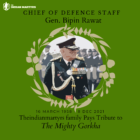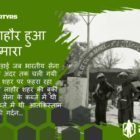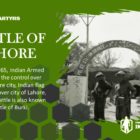|
Listen here
|

Major Ramaswamy Parameswaran was born on 13 September 1946, in Bombay, Maharashtra. His parents were KS Ramaswamy and Janaki. He did his schooling at South Indian Education Society High School, Mumbai in 1963. and graduated in Science from South Indian Education Society College in the year 1968.
Major Ramaswamy Parameswaran was inspired by the courage and sacrifice of the soldiers who fought against Pakistan in the 1971 war. So he joined Officers Training Academy (OTA) in 1971. From there he exceeded on June 16, 1972. After this, he was appointed as a commissioned officer in the 15 Mahar regiment of the Indian Army. There he served for eight years, after which he became part of 5 Mahars.
Major Ramaswamy Parameswaran also participated in the war in Mizoram and Tripura. He was a very popular officer because of his discipline and tolerance in his nature and was called ‘Peri Saheb’ by his companions. Whenever his unit undertook any challenging mission, he was at the forefront. The discussion of his bravery, courage, and determination was on everyone’s tongue.
It was in 1987 when the civil war in Sri Lanka was at its peak which was running since July 1983. The main reason for this was the misbehavior of the majority with the minority within the boundary. The attitude of the Sinhalese majority government of Sri Lanka was not right with the minority Tamils. Their interests were exploited to some extent, due to this the anger spread within the Tamil community took the form of rebellion. They later began agitations demanding an independent Tamil Eelam state. The demand for a separate Tamil Eelam state had led to the formation of several militant organizations of Tamils, one of which was the insurgent organization Liberation Tigers of Tamil Eelam (LTTE).
The Sri Lankan government began targeting Tamils when they saw LTTE launched an armed struggle for a separate state. When Tamils started being targeted, a large number of Tamil citizens started relocating from Sri Lanka to Tamil Nadu as refugees. To deal with the refugee problem, on 29 July 1987 India and Sri Lanka signed an agreement. According to this agreement, India was to send its Indian Peacekeeping Force (IPKF) to Sri Lanka to face the riot and create a peaceful atmosphere there and so that refugees stop coming to India.
Under this agreement, Operation Pawan was launched by the Indian Army in Sri Lanka, Major Ramaswamy Parameswaran was selected to serve in the 8 Mahar Battalion. 8 Mahar was the first battalion that was sent to Sri Lanka in 1987.
On 24 November 1987, the battalion led by Major Ramaswamy Parameswaran received information that a large cache of arms and ammunition had landed in Kantarodai village near Uduvil town in Jaffna. Major Pareshwaran’s team was assigned the responsibility of the search operation there. They arrived for the search and siege one house, and then he had decided that the search would be done in the morning. The next day when they started searching that house, they were attacked by LTTE militants. Bullets started raining from all sides but despite the attack, Major Parameswaran and his team proceeded to search the house.
The militants were using AK-47s, grenades, and dangerous heavy machine guns. The LTTE cadres had also placed landmines in that area so that soldiers could not reach there and also LTTE militants were experts in ambush attacks. Keeping this situation in mind, he made a plan to beat the LTTE with his own trick. He took 10 of his soldiers and started crawling towards the coconut bush from where the LTTE militants were being ambushed. In this way, his team surrounded the militants from all sides but suddenly a sniper sitting on a coconut tree attacked with a machine gun which hit his left wrist. His left hand became completely useless. Irrespective of this, he grabbed the weapon of the militant standing close to him and killed that sniper, then another bullet came which hit on his chest. He was martyred in this attack on 25 November 1987.
During the Sri Lankan Civil War, Major Ramaswamy Parameswaran showed his bravery and cunning for which the Indian government awarded him with Param Vir Chakra, India’s highest military decoration.





